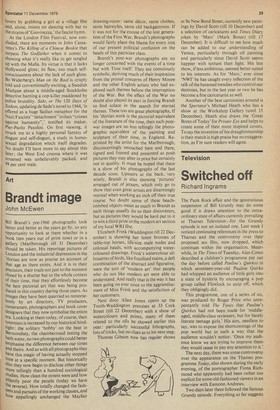Brandt image
John McEwen
Bill Brandt's pre-1960 photographs look better and better as the years go by, so any oPportunity to look at them whether in a hook (ten years out of print now) or in a gallery (Marlborough till 31 December) Should be taken. His reportage pictures of London and the industrial depression in the thirties are now as precise an account of that age as there exists. And it is in their Precision, their truth not just to the moment Closed by a shutter but to the whole context of their time, that they effortlessly become the best pictorial art that was being produced in this country during those years. As Images they have been quarried so remorselessly by art directors, TV producers, cameramen, photographers and book cover designers that they now symbolise the entire era. Looking at them today, of course, their totemism is increased by our historical hindsight: the solitary 'bobby' on the beat in Bermondsey, the chambermaid testing the bath water, no two photographs could better emphasise the difference between our times and theirs. And as with all photographs they have this magic of having actually stopped time at a specific moment. But historically also they now begin to disclose other things More tellingly than a hundred sociological studies. How clean the streets were and how abjectly poor the people (today we have he reverse). How totally changed the fashions and pursuits of the working classes, and how appallingly unchanged the Mayfair
drawing-room: same decor, same clothes, same hairstyles, same old backgammon. If it was not for the excuse of the lost generation of the First War, Brandt's photographs would fairly place the blame for every iota of our present political confusion on the heads of this patrician class.
Brandt's post-war photographs are no longer concerned with the events of a time but with Time itself. They are consciously symbolic, deriving much of their inspiration from the primal concerns of Henry Moore and the other English artists who had explored such themes before the interruption of the War. But the effect of the War no doubt also played its part in forcing Brandt to find solace in the search for eternal themes. These too are great photographs. If his 'thirties work is the pictorial equivalent of the literature of the time, then such postwar images are no less tellingly the photographic equivalent of the painting and sculpture of their time, in England. Reprinted by the artist for the Marlborough, disconcertingly retouched here and there, signed and framed and presented as posh pictures they may alter in price but certainly not in quality. It must be hoped that there is a show of his photographs of the last decade soon. Upstairs at the back, very wisely, Brandt is also showing 'pictures' arranged out of jetsam, which only go to show that even great artists are disarmingly normal when working an inch off their true course. No doubt some of these beachcombed objects mean as much to Brandt as such things usually do to their discoverers, but as pictures they would be hard put to it to win a third prize in the modern art section of my local WRI fete.
Elizabeth Frink (Waddington till 22 December) is showing her latest bronzes of table-top horses, life-size male nudes and colossal heads, with accompanying watercoloured drawings. Frink's watercolour silhouettes of birds, like fossilised stains, a deft combination of the abstract and figurative, were the sort of 'modern art' that people who do not like modern art were able to understand. And really that is the way it has been going on ever since to the aggrandisement of Miss Frink and the satisfaction of her customers.
Next door Allen Jones opens up the Tooth-Waddington premises at 33 Cork Street (till 22 December) with a show of watercolours and prints, many of them related to the oils he showed earlier this year: particularly successful lithographs, lots of tricks, but no clues as to his next step.
Thomas Gibson now has regular shows
at 9a New Bond Street, currently new paintings by David Scott (till 10 December) and a selection of caricatures and Times Diary jokes by 'Marc' (Mark Boxer) (till 17 December). It is difficult to see how much can be added to our understanding of Venice, particularly through oil painting and particularly since David Scott seems happier with texture than light. His last show, if less ambitious, seemed better suited to his interests. As for 'Marc,' ever since 'NWT' he has caught every inflection of the talk of the harassed trendies who control our destinies, but in the last year or two he has become a fine caricaturist as well.
Another of the best cartoonists around is the Spectator's Michael Heath who has a show at the Workshop Gallery (until 15 December). Heath also draws the 'Great Bores of Today' for Private Eye and helps to create some of their more inspired covers. To say the invention of his draughtsmanship is their match is high praise but no exaggeration, as I'm sure readers will agree.


































 Previous page
Previous page